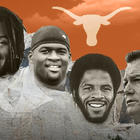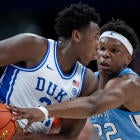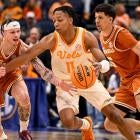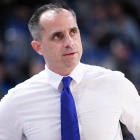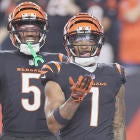College football is filled with historic figures, some of whom have become bigger than life as the years have passed. These are the kind of figures who would be carved in stone somewhere in South Dakota as a monument to all they accomplished.
With that in mind, we here at CBS Sports have decided to build Mount Rushmores for some of college football's most historic programs. Today, we look at the men who helped build the behemoth that is Texas Longhorns football.
This was no easy task. How do you boil down more than 120 years of college football history -- including four claimed and 11 unclaimed national titles -- to just four coaches, players and administrators?
Let's take a look at the four figures that have truly brought glory to the Longhorns.
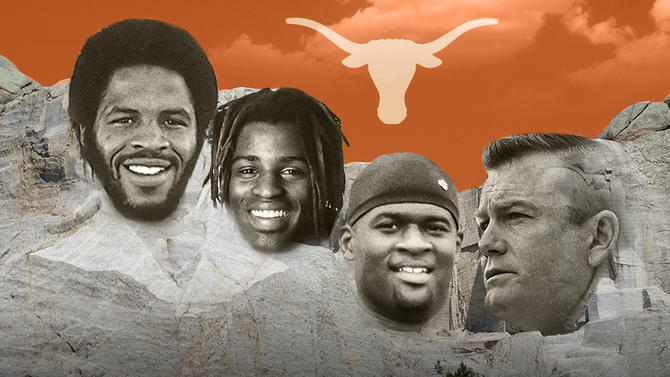
Earl Campbell, running back 1974-77: No one in Texas' wildly successful history deserves the No. 1 spot more than Campbell, one of the most powerful and prolific running backs to ever play the game. In terms of prominence within the Longhorns community, it doesn't hurt that Campbell, "The Tyler Rose," remains an important figure in Austin and with Texas athletics along with having an award in his honor.
Campbell was not the only Texas rusher to win the Heisman (more below), but no Longhorns player had brought the stiff-arm trophy back to Austin before Campbell. Having both players on this Mount Rushmore was a no-brainer because of what they represented to the storied program, but also because of how awe-inspiring their presence was on the football field. I wasn't alive for Campbell, but thankfully we've got the highlights to showcase how this lifetime Texan could make a 5-yard gain turn into 50 and put the team on his back in any situation.
Accolades: 1977 Heisman Trophy, First Team All-American (1975, 1977), No. 20 retired by UT
Ricky Williams, running back, 1995-98: Williams is more of my vintage. He's a player who does not require documentaries or YouTube highlights for most reading this to remember his impact. What Williams brings to the table, as highlighted below, is the incredible combination of strength and breakaway speed that made him such a game-changer. A few steps, a quick shake, one broken tackle and then Williams was gone. In his last two seasons, Williams had 54 rushing touchdowns, many of them coming after long runs created by this incredible ability to spring to the second level and out into the open field.
The "Run Rickie Run" signs were part of a national hysteria that started with Williams' 385 rushing yards and nine touchdowns in the first two games of the 1998 season. His tear through that senior season propelled his career totals to the point of breaking Tony Dorsett's then-NCAA rushing record, an honor that included a hat-tip from Dorsett himself.
Accolades: 1998 Heisman Trophy, Doak Walker Award, consensus All-American (1997-98), No. 34 retired by UT
Vince Young, quarterback, 2002-05: We will always remember Young and the Rose Bowl. With 467 yards of offense (267 passing, 200 rushing) in the 2006 BCS Championship Game and 372 yards of total offense in the 2005 Rose Bowl game, Longhorns fans will forever remember Young for how he finished seasons and capped his career.
Young was able to change the game and the course of Texas football history with his dual-threat ability during the 2005 season (and his 30-2 career record as a starter ain't too shabby). He threw for 3,036 yards and ran for 1,050 yards during that year with 38 total touchdowns. While Colt McCoy would go on to break some of Young's school records just a few years later, Young's breakthrough meant far more to a Texas program that had been starving for a return to the top of the college football world.
One of my favorite anecdotes from that amazing game (the best college football game of my lifetime) actually came from USC defensive end Lawrence Jackson in Dennis Dodd's oral history of the game earlier this year. Jackson had a direct line to Young with a chance to make the stop that would have won the title for the Trojans.
"It was literally like magic," Jackson said. "One moment Young was there and the next minute, he wasn't. Make the play and win and [we] go on and be one of the greatest college teams ever."
Young didn't win the Heisman Trophy that year; Reggie Bush did. I don't care what the record book says, Bush won that Heisman and was the most dominant player in college football in the regular season. According to my friends, Young stole the Heisman with the play below.
Accolades: National champion, two-time Rose Bowl MVP, Maxwell Award
Darrel Royal, coach, 1957-76: The man with his name on the dang stadium has to be on Mount Rushmore, right? Royal was the coach in Austin for two decades. He won three titles, never had a losing season and was lucky enough to be the first coach for Earl Campbell, also on this Rushmore, before he stepped down but continued his role as athletic director. Oh yeah, Royal was also Texas' athletic director. His place on the Mount Rushmore is necessary not just because his name is on the stadium but because of what he gave to the school during one of the most magical eras in the football program's storied history.
Accolades: Three-time national champion (1963, 1969-70), two-time Eddie Robinson Coach of the Year (1961, 1963), College Football Hall of Fame
![[object Object] Logo](https://sportshub.cbsistatic.com/i/2020/04/22/e9ceb731-8b3f-4c60-98fe-090ab66a2997/screen-shot-2020-04-22-at-11-04-56-am.png)








